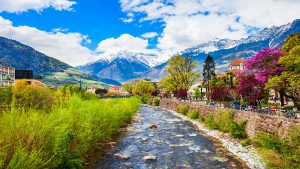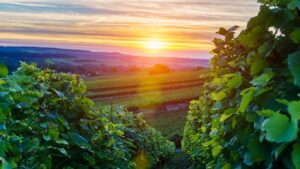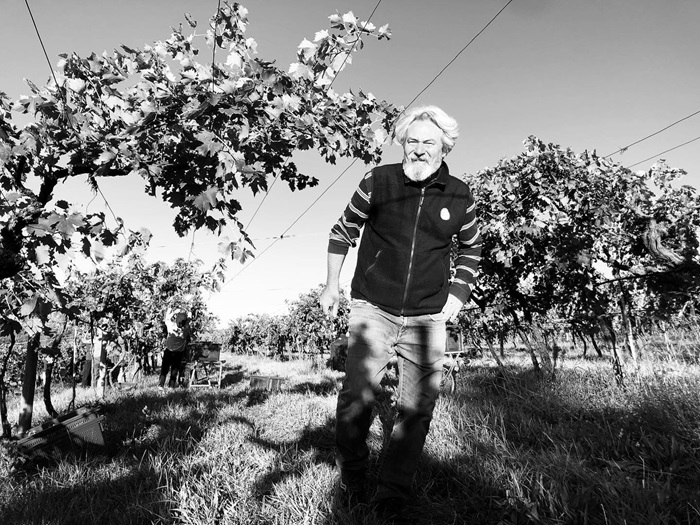
Filippo Filippi. A rather easy name to remember. Carving his own path in Soave (Veneto), this precise, non-interventionist organic winemaker is a strong contrast to the diluted, high-yield wines produced in the appellation. This is a man deeply attached to the land of his ancestors that have lived and worked on this ancient volcano since the 14th century. And a man who is equally proud of and respectful of his heritage, as evidenced by the splendid building that is Cantina Filippi. We paid Filippo a visit last year and here’s what we discovered about this fabulous producer.
Cantina Filippi, a peaceful haven in Castelcerino…
Castelcerino is a small village above the commune of Soave, located in the Verona Province, which gives its name to the local appellation. Let us take you on a tour as we had the opportunity to visit the estate last November. Vines, naturally, mostly on pergolas, and on slopes, as Castelcerino sits on the summit of an ancient volcano. Just past the pretty village of Castelcerino, with its typically Italian stone bell tower proudly overlooking the ochre and yellow church, you reach the last crossroads in the village. Some cypresses and other conifers, a stone Calvary, and a motorhome park – our hosts like to entertain guests on their premises – take the dirt track on the left. The impressive building you can see behind the charming stone gate is Cantina Filippi. A peaceful, harmonious haven where time seems to have stopped.
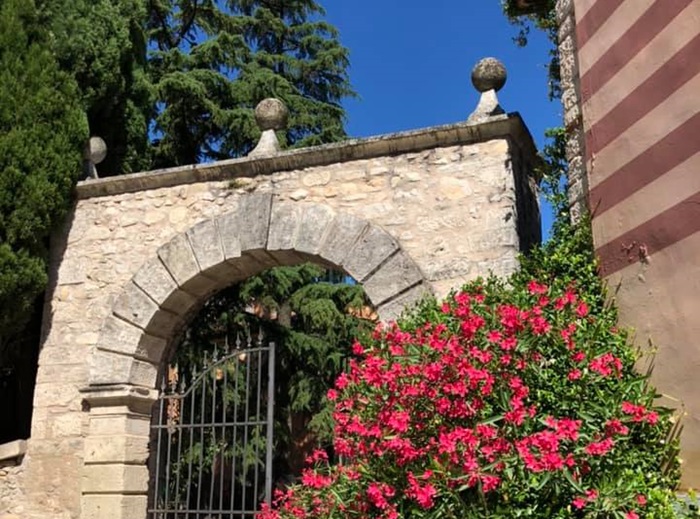
Filippo Filippi. Now that’s an unusual name that’s really easy to remember. Filippo is the man behind this estate, originally established by a family rooted in these volcanic soils since the 14th century. The family turned their attention to wine production in the 20th century, and Filippo, 52, who has lived here his whole life, took over the business in 2003. The vines sit 320 metres above sea level and face south-east. The volcanic soil also contains underlying basaltic rocks.
… Steeped in history
The building now owned by the Filippi family was once a stronghold. It is recognisable by the famous dovetail embrasures adorning the estate’s tower, evidence of the past presence of the Della Scala family, the famous Scaligeri who ruled Verona and the surrounding area from 1260 to 1390 and, and were, by the end of their reign, unrivalled in Italy in terms of their power and wealth. The site where the estate is located is actually called Colli Scaligeri, which literally translates to ‘the Scaligeri Hill’. The Filippi family regularly conduct maintenance work on this historic site, which was covered in scaffolding when we visited.
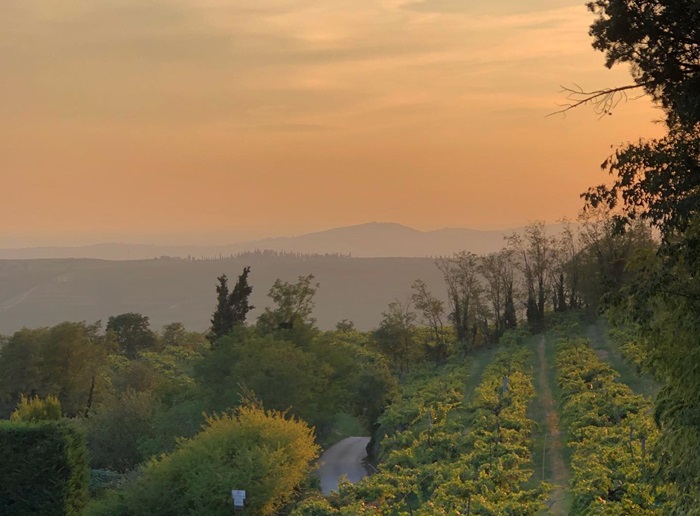
Against the Soave tide of insipid white wine
Let’s have a closer look at the Soave appellation. This was one of the first winegrowing areas to be mapped in Italy and is now considerably smaller than it was when the DOC was introduced in 1968. At that time, it was indeed decided to extend the appellation to thousands of hectares on the plains, where grapes produced higher yields. The direction was clear back then, with quantity favoured over quality, and consumers quickly perceiving Soave as a small, watered down, insipid white wine. Today, the appellation spans some 7,000 hectares and continues to be of little interest to aficionados with discerning palates. Wines are mass-produced, loaded with sulphur dioxide, heavily filtered… And yet a handful of winemakers are resisting the tide – often located in the higher, more demanding parts of the appellation – and Filippo is one of them. He strives to showcase local grape varieties such as Garganega (typically seen in the Veneto region) and Trebbiano di Soave, while reflecting the unique characteristics of the different terroirs where the vines thrive. To this end, everything is carefully thought out, right down to the finer points…
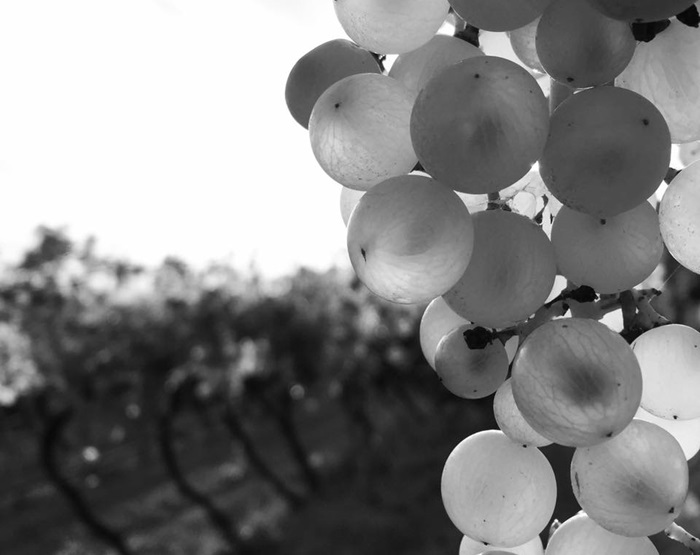
Tapping into the soil and its specific characteristics
“Here, the soil is very special,” explains Filippo, with a twinkle in his eye, translated into English by his trusty sidekick Paola. His grandfather understood this and produced his wines alone. When Filippo took over the business, grapes were sent to the cooperative, but the winemaker put a stop to this practice and for the last 20 years put all his energy into showcasing his terroirs by producing parcel-based cuvées and practising direct sales.
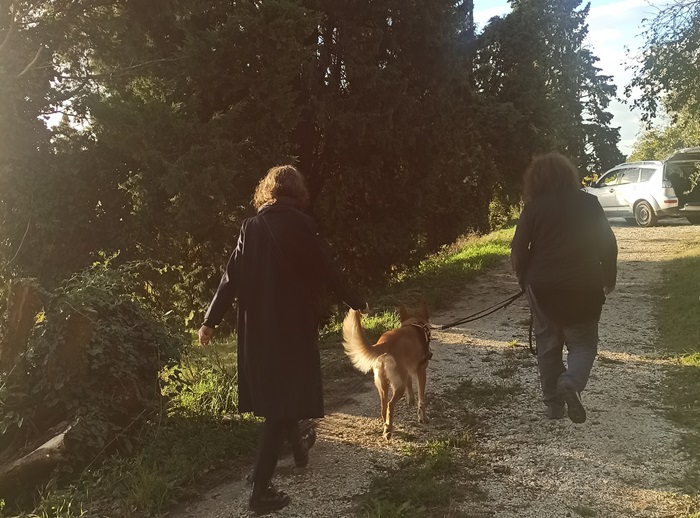
Surrounding the 14 hectares of vines are 22 hectares of woodland, which is extremely important for promoting biodiversity in the vineyard. We even enjoyed a 4 × 4 ride alongside Filippo, Paola and the estate’s faithful dog. At this point, we spotted the vines, mostly planted on 2-metre-high pergolas designed to shield the grapes from the sun and protect them from the very hot soil. The vines are old, averaging 50 to 70 years. Organic viticulture has been implemented from the outset (awarded certification in 2007 and Triple A status two years ago), and work is carried out as naturally as possible. The vines produce extremely low yields compared with the rest of the appellation.
The grapes are harvested slowly by hand – only two extra people come to help the estate’s small team – and are placed in 12 kg crates before being taken to the winery. Very little sulphite is involved in the entire process and pressing is swift, with or without maceration. The ageing process is relatively similar for all the cuvées, to better capture the differences in the terroirs with wines spending at least 12 months in stainless steel vats. The wines are not filtered and since 2015, they have been sealed with screw caps. The result? Authentic, fresh, lively and fruit-forward wines, pleasingly chewy with a slightly tannic mouthfeel. “Filippo produces wine for drinking,” says Paola.
Tasting the estate’s wines: Lively and vibrant nectars
The tasting begins in one of the building’s large reception rooms. With thick stone walls, a solid wooden table, exposed beams, old statues and frames displayed… The decor is authentic. We begin with 2022, an extremely dry year, during which the rain went on holiday and restricted quantity. 2023? “A little more volume, but also more powdery mildew, and we had to carry out a lot of sorting in the vineyard, losing roughly half.” Filippo speaks to us in Italian occasionally, and our gazes and nods are so full of conviction – though we don’t really understand – that Paola doesn’t even translate for us. Yet this was a wonderful and memorable experience of sharing and tasting.
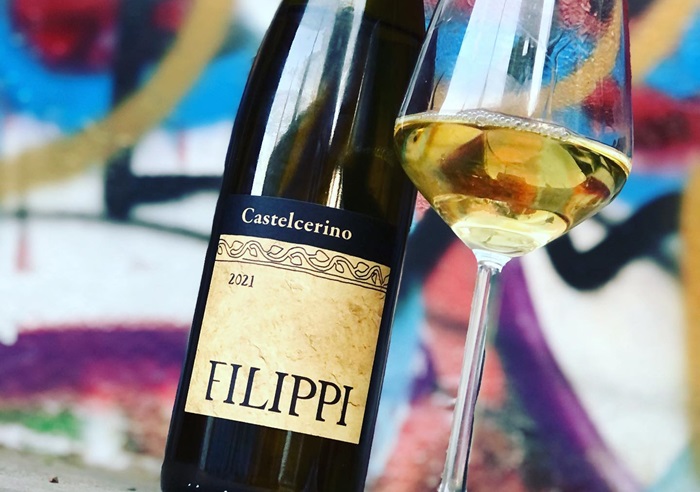
These three Soaves stem from completely different soils, hence the decision to separate them into three distinct cuvées.
- Soave DOC Castelcerino 2022 Colli Scaligeri
The 8 hectares of Garganega that produce this cuvée are located below the cantina. The slightly smoky nose is intensely fruity and vibrant, conveying an impression reminiscent of a natural wine from the Jura or the Loire Valley. The palate is balanced, round and deliciously salivating.
Filippo recommends drinking it between within 5 to 20 years.
- Soave DOC Vigne della Bra 2022
This soil is more clayey and volcanic than that of the previous cuvée. An equally smoky, spirited nose leads to fresh notes of lemon. The initially slightly pearly, extremely pure palate reveals a fine minerality and a deliciously salivating finish of bitter almond.
This cuvée is so versatile that we start talking about recipes and food pairings. Mouth-watering.
- Soave DOC Monteseroni 2022
This cuvée is produced from a single hectare of vines. The nose is lively, bursting with notes of white fruit mingling with the minerality of wet stone. Natural and pure on the palate, this wine oozes iodine and delivers a long, mouth-watering finish.
Let’s keep going!
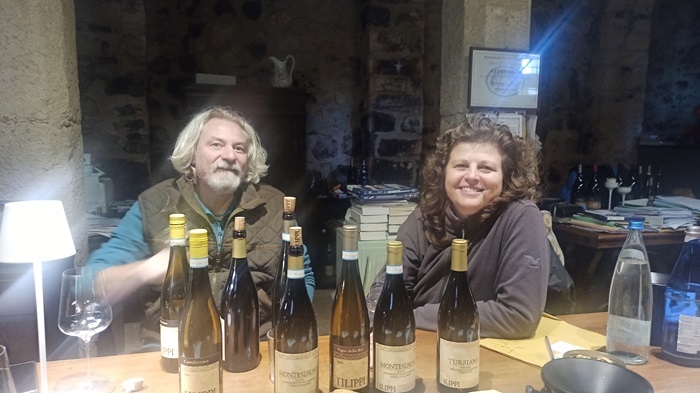
- Turbiana 2022
This wine bears the name of its grape variety, Turbiana, also known as Trebbiano di Soave, a variety widely grown in the Veneto region. Here, it thrives on a terroir of limestone soil stretching over one hectare and the young vines come from a rigorous massal selection conducted by the estate.
On tasting, the nose reveals a delightful basket of white fruit, creating an elegant, charming cuvée. It is well balanced on the palate, blending finesse and character. The finish is marked by notes of pepper and exceptional length. A real favourite or ours!
- Soave DOC Castelcerino 2019 Colli Scaligeri
This 2019 displays a fresh nose of melon, kumquat and citrus fruit. The palate reveals an impression of light maceration and is well balanced and long.
- Soave DOC Monteseroni 2022 – Pressé au pied
This is the same wine as the one we tasted earlier. But this time; it is fermented in amphorae with the skins, pressed down by a large stone – for the past four years – and matured for eight months. This nectar is even more natural than the others. The intensely fruity melon nose carries through to a delicate palate, revealing a chewy texture and a salivating finish.
We’d like to thank Filippo and Paola again for their warm welcome and wonderful visit. We strongly recommend you try their wines, which will give you a very good idea of what Soave wines can really offer.

